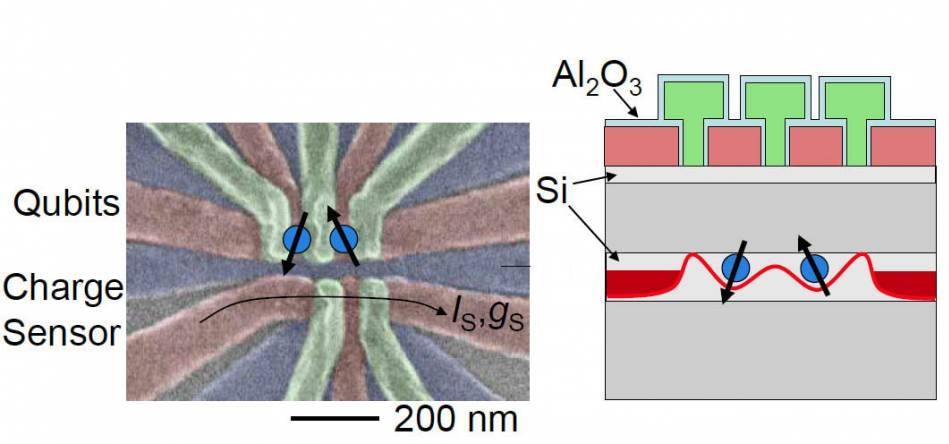Dec 12 2017
A team headed by researchers at Princeton University has designed an essential piece of silicon hardware, which marks a breakthrough step toward making quantum computers using everyday materials. This silicon structure can control quantum behavior between two electrons with excellent precision. The study has been reported in the journal Science.
 The two-qubit silicon-based gate consists of two electrons (blue balls with arrows) in a layer of silicon (Si). By applying voltages through aluminum oxide (Al2O3)wires (red and green), the researchers trapped the electrons and coaxed quantum behaviors that transform their spin properties into quantum bits of information, or qubits. The image on the left shows a scanning electron micrograph of the device, which is about 200 nanometers (nm) across. The image on the right is a diagram of the device from the side. (Image courtesy of Science/AAAS)
The two-qubit silicon-based gate consists of two electrons (blue balls with arrows) in a layer of silicon (Si). By applying voltages through aluminum oxide (Al2O3)wires (red and green), the researchers trapped the electrons and coaxed quantum behaviors that transform their spin properties into quantum bits of information, or qubits. The image on the left shows a scanning electron micrograph of the device, which is about 200 nanometers (nm) across. The image on the right is a diagram of the device from the side. (Image courtesy of Science/AAAS)
A gate was constructed by the team that controls the interactions between the electrons in a way that enables them to behave as the quantum bits of data, or qubits, required for quantum computing. The recent demonstration of this almost error-free, two-qubit gate marks a major early step in constructing a more complicated quantum computing device from silicon – the same material utilized in traditional smartphones and computers.
“We knew we needed to get this experiment to work if silicon-based technology was going to have a future in terms of scaling up and building a quantum computer,” said Jason Petta, a professor of physics at Princeton University. “The creation of this high-fidelity two-qubit gate opens the door to larger scale experiments.”
When compared to other technologies, silicon-based devices are probably less expensive and could be easily manufactured to realize a quantum computer. Interestingly, other companies and research groups have also announced quantum devices that contain 50 or more qubits, but those systems need charged atoms that are held in place by lasers or exotic materials such as superconductors.
Quantum computers are capable of solving many problems that are otherwise inaccessible with traditional computers. The devices could possibly factor very large numbers or even come up with optimal solutions for complicated problems. Also, quantum computers could help scientists to comprehend the physical properties of very small particles such as molecules and atoms, paving the way to advances in the fields of drug discovery and materials science.
In order to construct a quantum computer, researchers would need to generate qubits and combine them to one another with high fidelity. A quantum property of electrons known as “spin” is used by silicon-based quantum devices to encode information. This spin can point either up or down in a way similar to a magnet’s south and north poles. On the other hand, traditional computers operate by exploiting the negative charge of electrons.
The fragility of spin states makes it difficult to achieve a high-performance, spin-based quantum device. Unless they can be isolated in an extremely pure environment, these spin states readily flip from down to up or vice versa. The researchers built the silicon quantum devices in Princeton’s Quantum Device Nanofabrication Laboratory which allowed them to keep the spins coherent — i.e., in their quantum states — for an extended period of time.
In order to build the two-qubit gate, the researchers used a highly ordered silicon crystal on which they layered small aluminum wires. Voltages delivered by the wires trap a pair of single electrons, isolated by an energy barrier, in a unique well-like structure known as a double quantum dot.
The researchers then temporarily lowered the energy barrier, allowing the electrons to share quantum information and ultimately producing a unique quantum state known as entanglement. These entangled and trapped electrons can now be used for qubits, which are similar to traditional computer bits but have superpowers: Although a standard bit can indicate a zero or a 1, each qubit can be a zero and a 1 simultaneously, thus considerably expanding the number of potential permutations that can be compared immediately.
The challenge is that it’s very difficult to build artificial structures small enough to trap and control single electrons without destroying their long storage times, this is the first demonstration of entanglement between two electron spins in silicon, a material known for providing one of the cleanest environments for electron spin states.
David Zajac, first-author on the study, graduate student in physics at Princeton.
The team showed that the first qubit can be used to control the second qubit, indicating that the structure worked as a controlled NOT, or CNOT, gate, which is basically the quantum version of a oft-used computer circuit component.
By applying a magnetic field, the researchers are able to control the behavior of the first qubit. The gate generates a result depending on the state of the first qubit: if the first spin is pointed upwards, the second qubit’s spin will flip, but if the first spin is pointed downwards, then the second qubit’s spin will not flip.
“The gate is basically saying it is only going to do something to one particle if the other particle is in a certain configuration,” Petta said. “What happens to one particle depends on the other particle.”